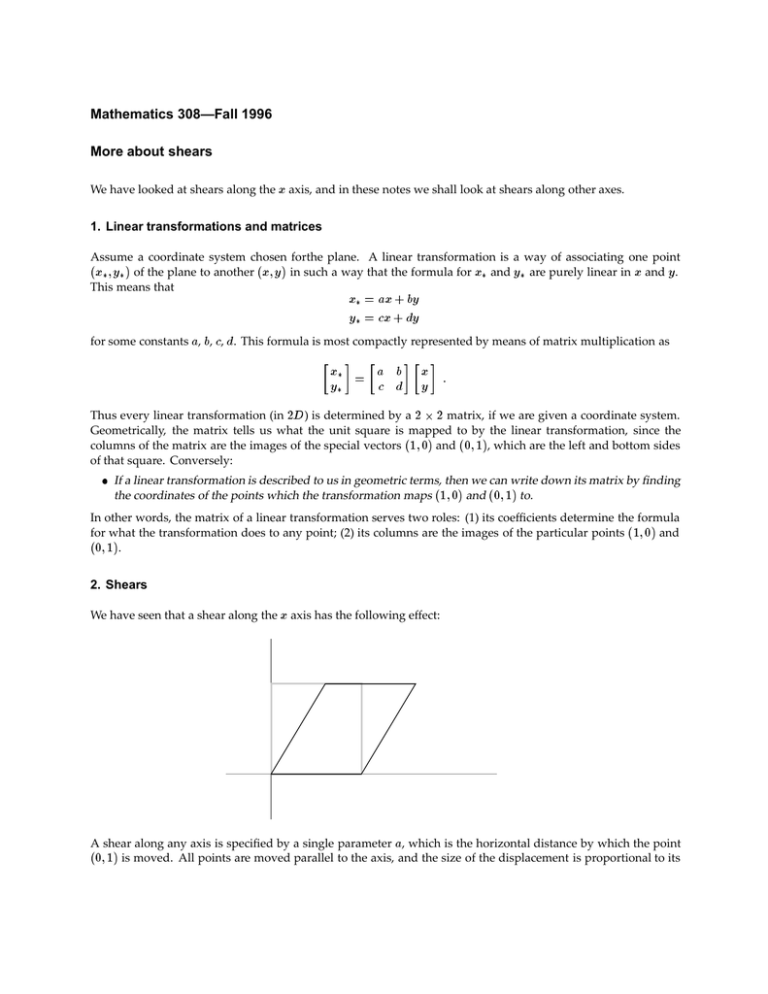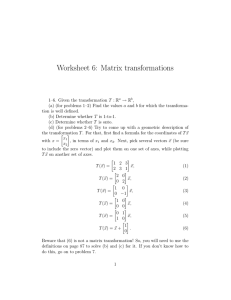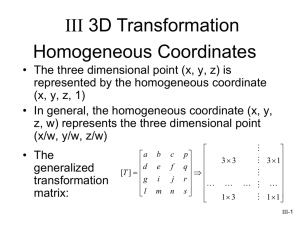Mathematics 308—Fall 1996 More about shears 1. Linear transformations and matrices
advertisement

Mathematics 308—Fall 1996 More about shears We have looked at shears along the x axis, and in these notes we shall look at shears along other axes. 1. Linear transformations and matrices Assume a coordinate system chosen forthe plane. A linear transformation is a way of associating one point (x ; y ) of the plane to another (x; y ) in such a way that the formula for x and y are purely linear in x and y . This means that x = ax + by y = cx + dy for some constants a, b, c, d. This formula is most compactly represented by means of matrix multiplication as x y = a c b d x y : Thus every linear transformation (in 2D ) is determined by a 2 2 matrix, if we are given a coordinate system. Geometrically, the matrix tells us what the unit square is mapped to by the linear transformation, since the columns of the matrix are the images of the special vectors (1; 0) and (0; 1), which are the left and bottom sides of that square. Conversely: If a linear transformation is described to us in geometric terms, then we can write down its matrix by finding the coordinates of the points which the transformation maps (1; 0) and (0; 1) to. In other words, the matrix of a linear transformation serves two roles: (1) its coefficients determine the formula for what the transformation does to any point; (2) its columns are the images of the particular points (1; 0) and (0; 1). 2. Shears We have seen that a shear along the x axis has the following effect: A shear along any axis is specified by a single parameter a, which is the horizontal distance by which the point (0; 1) is moved. All points are moved parallel to the axis, and the size of the displacement is proportional to its More about shears 2 distance from the axis. The constant of proportionality is a. A shear is a linear transformation. A shear along the x axis transforms the point (x; y ) according to the rule x y 7! x + ay y Therefore its matrix is = 1 a 0 1 1 a 0 1 x y : : Here is what a shear along another axis looks like: We want now to answer the question: suppose we choose as axis a line at angle with respect to the x axis. What is the matrix of a shear along this axis with parameter a? According to the rule explained in the first section, we must figure out the images of the vectors (1; 0) and (0; 1). In fact, we have the following rule for figuring out the image of any vecor v . The basis of this calculation is the fact that we know very explicitly how to calculate the image of any vector with respect to a shear along the x axis, and we want to reduce our new problem to that case. We can do that if we rotate the vector v by to move it to the same position relative to the x axis that v has relative to the new axis. We then shear this rotated vector, and then we rotate it back agin by to get back to our original configuration. In other words, the shear by displacement a aong the axis at angle is the same as a combination of three transformations: Ta; = R Ta R and therefore the matrix we want to calculate is cos sin sin cos 1 a 0 1 cos sin sin cos :






